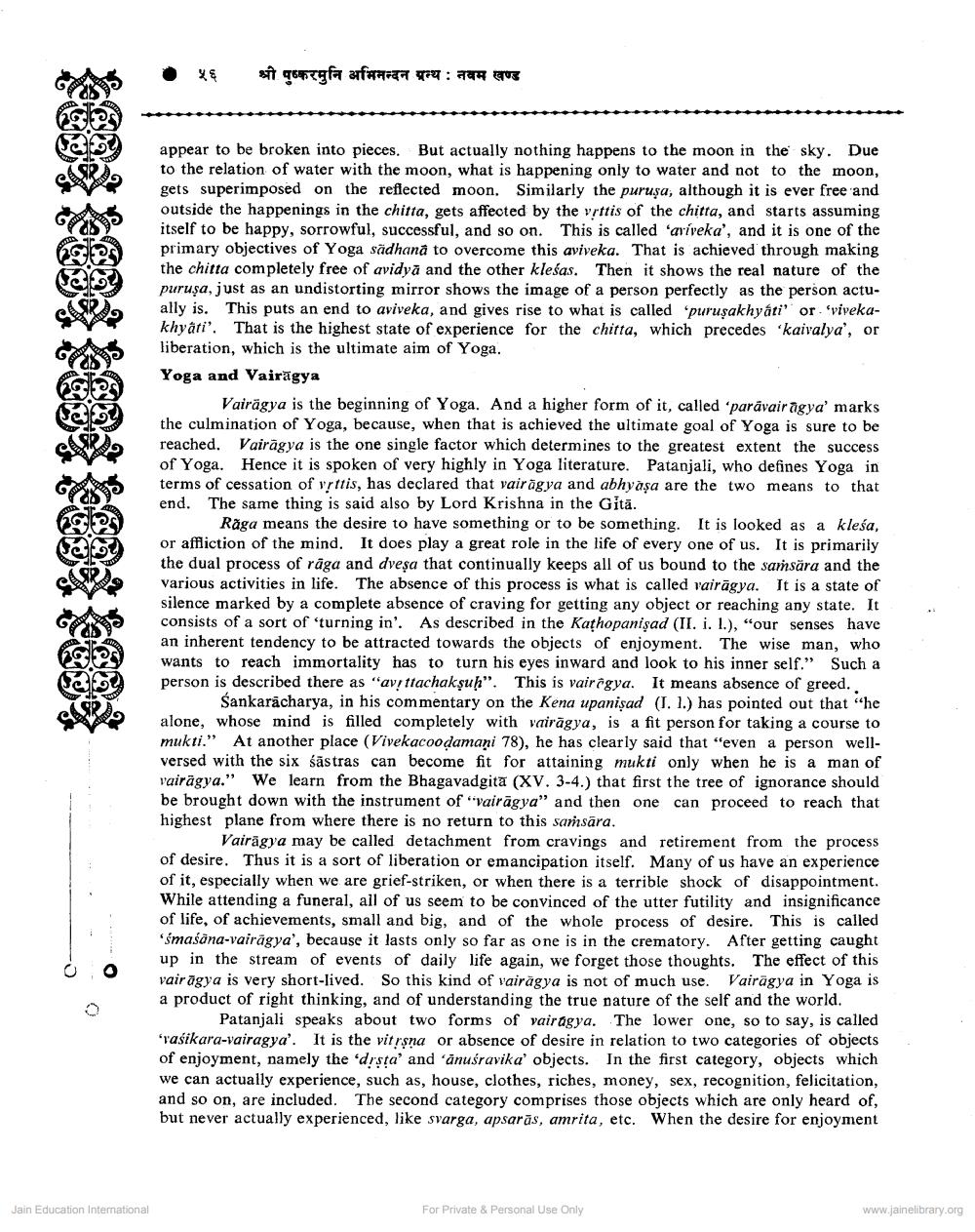Book Title: Yoga Personality mind and Vairagya Author(s): K S Joshi Publisher: Z_Pushkarmuni_Abhinandan_Granth_012012.pdf View full book textPage 5
________________ ५६ श्री पुष्करमुनि अभिनन्दन ग्रन्थ : नवम खण्ड appear to be broken into pieces. But actually nothing happens to the moon in the sky. Due to the relation of water with the moon, what is happening only to water and not to the moon, gets superimposed on the reflected moon. Similarly the puruşa, although it is ever free and outside the happenings in the chitta, gets affected by the writis of the chitta, and starts assuming itself to be happy, sorrowful, successful, and so on. This is called 'ariveka', and it is one of the primary objectives of Yoga sädhana to overcome this aviveka. That is achieved through making the chitta completely free of avidy, and the other klešas. Then it shows the real nature of the puruşa, just as an undistorting mirror shows the image of a person perfectly as the person actually is. This puts an end to aviveka, and gives rise to what is called "puruşakhyati' or 'vivekakhyāti'. That is the highest state of experience for the chitta, which precedes "kaivalya', or liberation, which is the ultimate aim of Yoga. Yoga and Vairāgya Vairagya is the beginning of Yoga. And a higher form of it, called 'parāvair agya' marks the culmination of Yoga, because, when that is achieved the ultimate goal of Yoga is sure to be reached. Vairāgya is the one single factor which determines to the greatest extent the success of Yoga. Hence it is spoken of very highly in Yoga literature. Patanjali, who defines Yoga in terms of cessation of writis, has declared that vairāgya and abhyaşa are the two means to that end. The same thing is said also by Lord Krishna in the Gitā. Räga means the desire to have something or to be something. It is looked as a kleša, or affliction of the mind. It does play a great role in the life of every one of us. It is primarily the dual process of rāga and dveşa that continually keeps all of us bound to the samsara and the various activities in life. The absence of this process is what is called vairāgya. It is a state of silence marked by a complete absence of craving for getting any object or reaching any state. It consists of a sort of turning in'. As described in the Kathopanişad (II. i. I.), "our senses have an inherent tendency to be attracted towards the objects of enjoyment. The wise man, who wants to reach immortality has to turn his eyes inward and look to his inner self." Such a person is described there as "avttachaksuh". This is vairagya. It means absence of greed. Sankaracharya, in his commentary on the Kena upanişad (1. 1.) has pointed out that "he alone, whose mind is filled completely with vairāgya, is a fit person for taking a course to mukti." At another place (Vivekacoodamani 78), he has clearly said that "even a person wellversed with the six śāstras can become fit for attaining mukti only when he is a man of vairāgya." We learn from the Bhagavadgita (XV. 3-4.) that first the tree of ignorance should be brought down with the instrument of 'vairāgya" and then one can proceed to reach that highest plane from where there is no return to this samsāra. Vairāgya may be called detachment from cravings and retirement from the process of desire. Thus it is a sort of liberation or emancipation itself. Many of us have an experience of it, especially when we are grief-striken, or when there is a terrible shock of disappointment. While attending a funeral, all of us seem to be convinced of the utter futility and insignificance of life, of achievements, small and big, and of the whole process of desire. This is called 'smaśāna-vairāgya', because it lasts only so far as one is in the crematory. After getting caught up in the stream of events of daily life again, we forget those thoughts. The effect of this vairāgya is very short-lived. So this kind of vairāgya is not of much use. Vairagya in Yoga is a product of right thinking, and of understanding the true nature of the self and the world. Patanjali speaks about two forms of vairagya. The lower one, so to say, is called "rašikara-vairagya'. It is the vitrsna or absence of desire in relation to two categories of objects of enjoyment, namely the dista' and 'anusravika' objects. In the first category, objects which we can actually experience, such as, house, clothes, riches, money, sex, recognition, felicitation, and so on, are included. The second category comprises those objects which are only heard of, but never actually experienced, like svarga, apsarās, amrita, etc. When the desire for enjoyment 0 0 Jain Education International For Private & Personal Use Only www.jainelibrary.orgPage Navigation
1 ... 3 4 5 6
